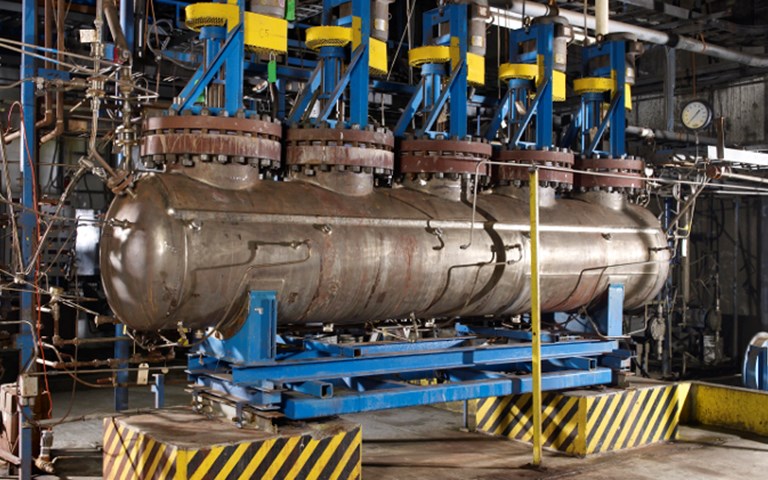Teck’s SDTC-funded project to eliminate smelting by placing refineries close to high-arsenic copper deposits will involve work at its CESL demonstration plant autoclave. Courtesy of Teck
Sustainable Development Technology Canada (SDTC) recently announced $206 million in funding for 36 clean technology projects across the country, including four projects by mining companies Alliance Magnesium, Avalon Advanced Materials, Quest Rare Minerals and Teck Resources. Minister of Innovation, Science and Economic Development Navdeep Bains announced the SDTC funding in early March.
SDTC has funded over 300 projects in 15 years. And though just 10 (totaling $40 million) have come from the mining sector, four successful applicants this year alone signals an increasing interest from the industry. “It is an area we have been interested in getting into even more,” said SDTC president and CEO Leah Lawrence. “We see recognition [from the industry] that sustainability needs to be integrated into mining. And we have some really strong leaders in that area, so we are starting to see momentum.”
SDTC has several priority investment areas when it comes to mining projects. One, not represented in this year’s recipients, is intelligent mining, or the application of data to the mining process.
A second involves attempts to eliminate the smelting process by refining near deposits, an approach taken by Teck, which is looking to place refineries close to high-arsenic copper deposits. “Refining on-site or close to the mine makes a lot of sense from cost, environmental and sustainability drivers,” said Keith Mayhew, manager of Teck’s CESL operations. Teck has partnered with the German refining company Aurubis to develop new technology to process concentrates hydrometallurgically rather than through smelting, to be tested at a two-year pilot plant in Richmond, British Columbia.
As high-grade copper deposits become scarce, companies are increasingly turning to lower-grade deposits, which often contain high levels of arsenic. “The amount of arsenic-containing copper concentrates is projected to significantly increase,” said Mayhew, “and smelters aren’t really designed to manage high-arsenic material.”
Teck’s process extracts copper at higher levels than smelters, and simultaneously stabilizes the arsenic to the residue. It produces none of the sulphur dioxide or arsenic emissions produced through smelting, and significantly reduces energy and water consumption.
SDTC’s third priority investment area is converting waste to products, as with a process developed by Alliance to remediate asbestos tailings to produce magnesium. Alliance is revamping the former Magnola plant in Asbestos, Quebec, improving the hydrometallurgy and electrolysis processes used at the plant by Noranda from 2000 to 2003. The SDTC funding will help test further improvements in engineering aimed at producing 50,000 tonnes by 2017, with full production soon after.
The process is meant to replace the thermal Pidgeon process used in China, which leads global primary magnesium production. As it is used today, the Pidgeon process relies heavily on energy from coal, and emits a lot of C02, explained Alliance CEO Joël Fournier. “It’s also very expensive because it requires a lot of energy. It takes five times the amount of energy required by electrolysis.” Alliance’s process drastically reduces C02 emissions, and virtually eliminates what remains through carbon capture.
There are also benefits downstream; magnesium demand is increasing, mainly from an automobile sector looking to improve fuel efficiency and cut greenhouse gas (GHG) emissions by reducing vehicle weight. Magnesium is a lighter alternative to metals traditionally used by the transportation and aerospace industry, like steel.
SDTC has also become interested in supporting rare earth projects. “We like those because they support the value chain of many other things we fund – LEDs, solar panels, stronger magnets – all of these things that enable clean technologies and renewable energies,” said Lawrence. “We think this is an area where Canada can play a significant role, and maybe develop to be a world leader.”
China dominates the rare earth market, and specifically those required for clean technology, like dysprosium, terbium, europium, neodymium and yttrium, which are already in short supply. Quest’s Strange Lake project in northern Quebec could change all that. “Strange Lake has one of the highest concentrations of environmentally-relevant rare earths in the world,” said Quest President Dirk Naumann. “The downstream opportunities are immense. And the resource we have in Strange Lake is good for 150 years, with a mining rate of 10,000 tonnes per year.”
Rare earth extraction is energy-intensive, and creates significant waste. Naumann, a chemical engineer, was brought on board to reconceive the process for Quest’s Bécancour plant. “I went back to the physical and chemical fundamentals, and threw out lots of unnecessary process steps, simplifying things,” he said.
The resulting Selective Thermal Sulphation (STS) process uses heat rather than chemicals to separate out impurities. High temperatures decompose all metal sulphates other than rare earths to insoluble components, and the remaining rare earths are dissolved in water. Sulphuric acid used in the processing is reused, rather than neutralized with calcium, which normally creates large amounts of solid tailings. The result is far fewer tailings and GHG emissions, and a two-thirds reduction in capital costs. “We will see 15 per cent of the tailings in Bécancour compared to what we initially put out in the prefeasibility study,” Naumann said.
Avalon also received funding for their Nechalacho rare earth project in the Northwest Territories, though due to market conditions the project has been put on hold and the funding deferred. Avalon has been looking at recycling chemicals used in the recovery process, thus reducing tailings, along with GHG emissions.
“It’s great that SDTC is recognizing that innovation in process metallurgy is important to sustainable development, and that a lot of these special metals and minerals such as rare earths are key to a lot of clean technology,” said Avalon president and CEO Don Bubar. “The fact that they are now recognizing that and supporting innovation in that sector is really good.”
It counters a perception that the mining industry is not doing anything new or innovative, said Bubar: “There’s actually quite a lot happening. And it’s finally getting some recognition.”




